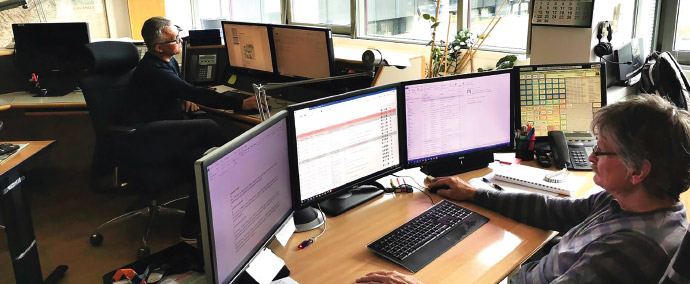Danube Watch 1/2020 - Emergencies
Emergencies:
Testing the Accident Emergency Warning System During the Corona Emergency

PIAC-SI during AEWS test: 12.5.2020 located in the Notification Centre of the Republic of Slovenia, under the administration of the RS for Civil Protection and Disaster Relief.
The show must go on. This old adage is as true now as it ever was. Indeed, for those responsible for the safety of all Danube River Basin citizens, the show did go on. Despite the Coronavirus crisis being well underway, and emergency precautions in effect throughout most of Europe, the execution of a thorough test of the Danube's Accident Emergency Warning System (AEWS) was followed through with – albeit, with a few small alterations.
The AEWS is activated whenever there is a risk of transboundary water pollution, or threshold danger levels of hazardous substances are exceeded. The AEWS can be used to send out international warning messages containing the relevant details about such incidents to the respective experts in the downstream Danube countries. This helps the authorities to put environmental protection and public safety measures into action very quickly. The first stage of the AEWS came into operation in April 1997 in Austria, Bulgaria, Czech Republic, Croatia, Germany, Hungary, Romania, Slovakia and Slovenia. Ukraine and Moldova entered the system in 1999; and Bosnia and Herzegovina and the Republic of Serbia have been on board since 2005.
This year, the regularly scheduled test took place on the 12th of May 2020, beginning at 10:00am. The ICPDR Secretariat - which not only maintains and operates the AEWS, but has overseen its development from a satellite to web-based, using SMS and e-mail alerts - system - distributed instructions before the test to the ICPDR Accident Prevention and Control Expert Group (APC EG) and the staff of the Principal International Alert Centres (PIACs) by email. Due to the cancellation of the 12th APC EG Meeting because of the Coronavirus crisis, the Secretariat supported the test via an online videoconference so that any APC EG and PIAC members who wanted to discuss the test proceedings and share experiences would be able to.
Danube Watch was able to sit in on a segment of the test proceedings (via online video conference, and from the comfort of home). This afforded us the chance to not only see the response to a spill warning in action, but also to have experts in a PIAC and other experts working from home explain the procedure and go through the steps for our sake. Many others were also active in the conference (almost all from their home-offices), though only observing with microphones muted. Obviously, these experts were already old hands at dealing with the technology and the decorum related to home-office video conferencing.
As for the test itself, it was divided into four incidents in order to involve all PIACs. Each PIAC had the tasks of confirming receipt of messages, creating a report to raise or follow-up on an alert, editing reports and closing alerts. The test simulated the case of a pollution plume in a river moving downstream before it could be eliminated and the danger subsided. When all PIACs ended their alerts, the respective incident was closed. The goal of this test was to check the functioning of the system and the cooperation of PIACs in handling an accident that propagates downstream a large international river.
From what we saw sitting in, the test appeared to go smoothly and without any major issues. While testing an alert system for major Danube accidents initially brought to mind any number of disaster movies, the very calm and even almost boring nature of the actual system was anything but a disappointment. Calm is good. Boring is good. If an outside observer can sit, watch and think that there is no excitement, it means that everything is working exactly as it should. It means that these regularly scheduled tests of the AEWS are proving their value – even as the 2020 Coronavirus crisis shakes the emergency preparedness of the world in a very different way.






